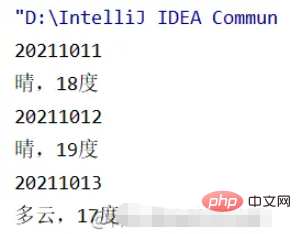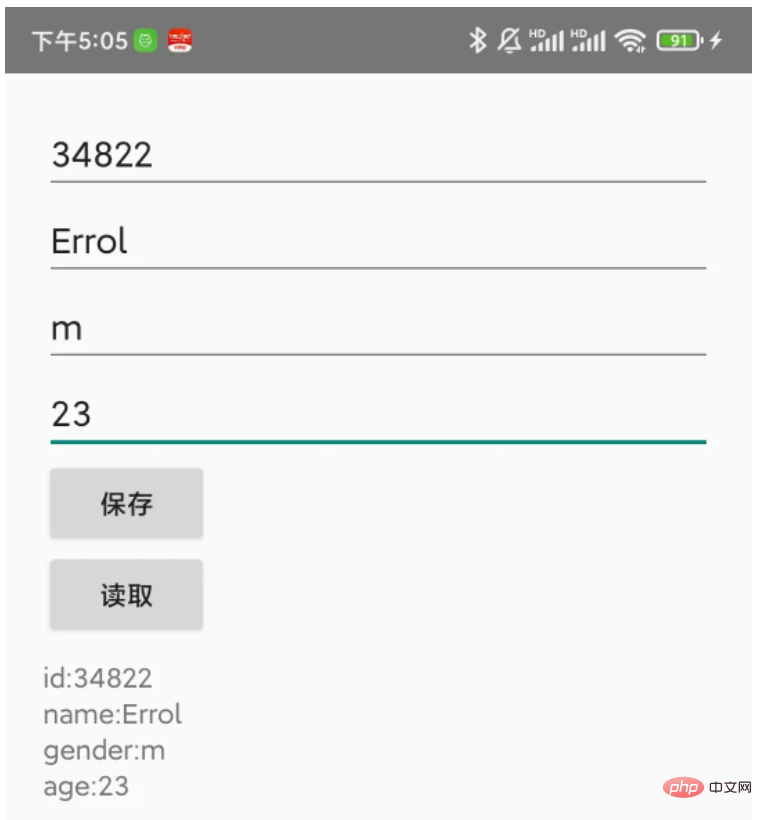Java의 DataInputStream 및 DataOutputStream을 사용하는 방법
- WBOYWBOYWBOYWBOYWBOYWBOYWBOYWBOYWBOYWBOYWBOYWBOYWB앞으로
- 2023-04-28 18:40:161940검색
소개
io 패키지에는 플랫폼 독립적인 두 가지 데이터 작업 스트림인 데이터 출력 스트림(DataOutputStream)과 데이터 입력 스트림(DataInputStream)이 제공됩니다.
일반적으로 데이터 출력 스트림은 특정 형식으로 데이터를 출력한 다음 데이터 입력 스트림을 통해 특정 형식으로 데이터를 읽습니다. DataOutputStream 및 DataOutputStream은 고정 바이트 형식 데이터를 읽고 쓰는 데 사용됩니다.
DataOutputStream
Create object
DataOutputStream out = new DataOutputStream(相接的流)
Methodint형 데이터를 데이터 출력 스트림에 쓰고, 최하위 레이어는 기본 출력 스트림에 4바이트를 씁니다
writeInt(int i)
double형 데이터를 데이터 출력에 씁니다. 스트림의 경우 맨 아래 레이어는 double을 long 유형으로 변환하여 기본 출력 스트림에 쓰고 8바이트를 출력합니다.
writeDouble(double d)
기계 독립적인 방식으로 utf-8 인코딩을 사용하여 기본 출력 스트림에 문자열을 씁니다. 먼저 문자열의 바이트 길이를 나타내는 2바이트를 출력한 후 다음 바이트 값을 출력합니다
writeUTF()
DataInputStream
Create object
DataInputStream dis = new DataInputStream(InputStream in);
Method데이터 입력 스트림에서 int 유형 데이터를 읽고, 4바이트를 읽습니다
readInt()
8바이트 읽기
readDouble()
먼저 2바이트를 읽어서 문자열의 바이트 길이를 확인한 다음, 이 바이트 값을 읽어보세요
readUTF()
팁:읽기가 끝나면 다시 읽을 때 EOFException이 발생합니다. 데이터 쓰기
public class Main {
public static void main(String[] args) throws Exception {
DataOutputStream out = new DataOutputStream(new FileOutputStream("d:/abc/f5"));
out.writeInt(20211011);
out.writeUTF("晴,18度");
out.writeInt(20211012);
out.writeUTF("晴,19度");
out.writeInt(20211013);
out.writeUTF("多云,17度");
out.close();
}
} 실행 결과:
 Chestnut 2: 읽기
Chestnut 2: 읽기
public class Main {
public static void main(String[] args) throws Exception {
DataInputStream in = new DataInputStream(new FileInputStream("d:/abc/f5"));
try {
while (true) {
int date = in.readInt();
String s = in.readUTF();
System.out.println(date);
System.out.println(s);
}
} catch (EOFException e) {
//正确读取结束,不需要处理
}
in.close();
}
} 실행 결과:
 Chestnut 3: 학생 정보 저장
Chestnut 3: 학생 정보 저장
학생 정보를 다음 형식으로 저장하는 데 필요합니다.
학번 00 00 00 01
이름 00 03 61 62 63성별 00 61
나이 00 00 00 16
<LinearLayout xmlns:android="http://schemas.android.com/apk/res/android"
android:layout_width="match_parent"
android:layout_height="match_parent"
android:orientation="vertical"
android:padding="20dp">
<EditText
android:id="@+id/et1"
android:layout_width="match_parent"
android:layout_height="wrap_content"
android:hint="学号" />
<EditText
android:id="@+id/et2"
android:layout_width="match_parent"
android:layout_height="wrap_content"
android:hint="姓名" />
<EditText
android:id="@+id/et3"
android:layout_width="match_parent"
android:layout_height="wrap_content"
android:hint="性别" />
<EditText
android:id="@+id/et4"
android:layout_width="match_parent"
android:layout_height="wrap_content"
android:hint="年龄" />
<Button
android:id="@+id/btn1"
android:layout_width="wrap_content"
android:layout_height="wrap_content"
android:text="保存" />
<Button
android:id="@+id/btn2"
android:layout_width="wrap_content"
android:layout_height="wrap_content"
android:text="读取" />
<TextView
android:id="@+id/tv"
android:layout_width="match_parent"
android:layout_height="wrap_content"
android:layout_marginTop="10dp" />
</LinearLayout>
public class IoActivity extends AppCompatActivity {
private EditText et1;
private EditText et2;
private EditText et3;
private EditText et4;
private Button btn1;
private Button btn2;
private TextView tv;
@Override
protected void onCreate(Bundle savedInstanceState) {
super.onCreate(savedInstanceState);
setContentView(R.layout.activity_io);
setViews();
setListeners();
}
private void setViews() {
et1 = findViewById(R.id.et1);
et2 = findViewById(R.id.et2);
et3 = findViewById(R.id.et3);
et4 = findViewById(R.id.et4);
btn1 = findViewById(R.id.btn1);
btn2 = findViewById(R.id.btn2);
tv = findViewById(R.id.tv);
}
private void setListeners() {
btn1.setOnClickListener(view -> baocun());
btn2.setOnClickListener(view -> duqu());
}
private void baocun() {
//IO操作有IO异常,所以进行try...catch...
/*
*
* ┌DataOutputStream
* ┌FileOutputStream
* sdcard
*/
try {
int id = Integer.parseInt(et1.getText().toString());
String name = et2.getText().toString();
String gender = et3.getText().toString();
int age = Integer.parseInt(et4.getText().toString());
DataOutputStream out = new DataOutputStream(
new FileOutputStream(getExternalFilesDir(null) + "/stu.txt", true)
);
out.writeInt(id);
out.writeUTF(name);
out.writeChar(gender.charAt(0));
out.writeInt(age);
out.close();
Toast.makeText(this, "保存成功", Toast.LENGTH_SHORT).show();
} catch (Exception e) {
Toast.makeText(this, "保存失败", Toast.LENGTH_SHORT).show();
e.printStackTrace();
}
}
private void duqu() {
//IO操作有IO异常,所以进行try...catch...
try {
DataInputStream in = new DataInputStream(
new FileInputStream(getExternalFilesDir(null) + "/stu.txt")
);
try {
tv.setText("");
while (true) {
int id = in.readInt();
String name = in.readUTF();
char gender = in.readChar();
int age = in.readInt();
tv.append("id:" + id + "\n" + "name:" + name + "\n" + "gender:" + gender + "\n" + "age:" + age + "\n");
}
} catch (EOFException e) {
}
in.close();
Toast.makeText(this, "读取成功", Toast.LENGTH_SHORT).show();
} catch (Exception e) {
Toast.makeText(this, "读取失败", Toast.LENGTH_SHORT).show();
e.printStackTrace();
}
}
}

 where
where
getExternalFilesDir(null)
이 디렉터리는 다음 위치에 있습니다. 애플리케이션이 제거되면 삭제됩니다. , 이 디렉터리에 액세스하는 데에는 STORAGE 권한을 위한 동적 애플리케이션이 필요하지 않습니다.
따라서 프로그램을 실행하면 이 경로에 stu.txt 파일이 생성됩니다
위 내용은 Java의 DataInputStream 및 DataOutputStream을 사용하는 방법의 상세 내용입니다. 자세한 내용은 PHP 중국어 웹사이트의 기타 관련 기사를 참조하세요!

